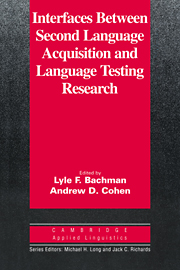Book contents
- Frontmatter
- Contents
- List of contributors
- Series editors' preface
- Preface
- Chapter 1 Language testing – SLA interfaces: An update
- Chapter 2 Construct definition and validity inquiry in SLA research
- Chapter 3 Research on interlanguage variation: Implications for language testing
- Chapter 4 Strategies and processes in test taking and SLA
- Chapter 5 Describing language development? Rating scales and SLA
- Chapter 6 Testing methods in context-based second language research
- Chapter 7 How can language testing and SLA benefit from each other? The case of discourse
- Appendix: Language testing – SLA research interfaces
- Index
Chapter 3 - Research on interlanguage variation: Implications for language testing
Published online by Cambridge University Press: 05 October 2012
- Frontmatter
- Contents
- List of contributors
- Series editors' preface
- Preface
- Chapter 1 Language testing – SLA interfaces: An update
- Chapter 2 Construct definition and validity inquiry in SLA research
- Chapter 3 Research on interlanguage variation: Implications for language testing
- Chapter 4 Strategies and processes in test taking and SLA
- Chapter 5 Describing language development? Rating scales and SLA
- Chapter 6 Testing methods in context-based second language research
- Chapter 7 How can language testing and SLA benefit from each other? The case of discourse
- Appendix: Language testing – SLA research interfaces
- Index
Summary
From the inception of research on second language acquisition (SLA), there has been an emphasis on the importance of studying authentic second language (L2) use in context. Selinker (1972) defined interlanguage as the linguistic system evidenced when adult second language learners attempted to express meanings in the language being learned. In attempting to model this underlying linguistic system, researchers were urged to use as data only
utterances produced by second-language learners when they were trying to communicate meaning in the target language. The relevant data were clearly not learner utterances produced in response to classroom drills and exercises where the learner was focusing attention on grammar rules or target language form.
(Tarone 1994: 1717)Thus, in its original formulation, the construct of “interlanguage” was construed to be the linguistic system revealed when learners were involved in authentic, situated L2 use. Although subsequent research has clearly used a much wider range of data than that originally envisioned by Selinker (1972), much – though not all – research in second language acquisition has continued to focus upon situated second language use. SLA theoreticians (e.g., Brown & Yule 1983a; Widdowson 1983) have provided useful frameworks for the study of contextualized second language use. However, it is important to note that theories of second language acquisition have been proposed that explicitly reject the value of authenticity of situational context for the study of second language acquisition (see Gregg 1990), and a great deal of SLA data has been gathered without particular regard for the influence of situational context (see Tarone 1988 for a discussion of this phenomenon).
- Type
- Chapter
- Information
- Publisher: Cambridge University PressPrint publication year: 1999
- 4
- Cited by



